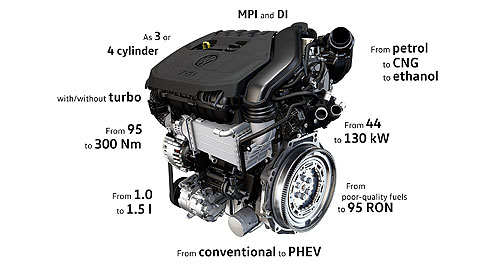News - VolkswagenVolkswagen evolves TSI engineEvolved: Volkswagen's new TSI engine may only displace a maximum of 1.5 litres, but it can pump out up to 130kW thanks to a high compression ratio, turbocharging and direct injection. Updated Volkswagen 1.5 TSI engine cuts consumption by up to 10 per cent29 Apr 2016 VOLKSWAGEN has updated its smallest TSI petrol engine line-up with a range of design, construction and control enhancements that not only result in greater fuel economy on a laboratory test rig, but also in real-world driving scenarios, according to the automotive giant. Exact fuel economy improvements depend on the configuration and in which model the engine is applied, but the German car-maker says, when compared with the outgoing 1.4 TSI, the equivalent EA211 TSI evo can boost economy by up to 10 per cent, representing a saving of up to 1.0 litre per 100km. In the case of the Golf 92TSI, fuel consumption could be reduced to as little as 4.4 litres per 100km, placing its economy within range of the most efficient diesel engines currently available. The engine made its debut at the 37th Vienna Motor Symposium in Austria this week and is being showcased in a variety of configurations from a 1.0-litre three-cylinder up to a 1.5-litre four-cylinder. Depending on the model, power and torque ranges from 44kW to 130kW and 95Nm to 300Nm and is offered with or without forced induction, and with a choice of multi-point or direct fuel injection. Volkswagen designed the new engine family with maximum flexibility in mind and it can be applied to a more conventional combustion-only powertrain or hybrid systems. Part of the increase in efficiency is attributed to the TSI's relatively high compression ratio of 12.5:1, which until only a few years ago was limited to natural aspiration only, but has been made possible through direct injection and Miller cycle variable valve timing. The more unorthodox cycle relies on the inlet valve remaining open into the compression stroke, allowing the turbocharger to continue filling the cylinder with air when the piston is on its way up. For the Miller cycle to be effective, the TSI's turbo must produce positive manifold pressure at low engine speeds, which is made possible with the use of a variable turbine geometry (VTG) turbo. At low exhaust velocities rotating vanes point the gas stream at the tips of the turbine to maximise compressor speed, but at higher exhaust velocity, the vanes aim gasses towards the centre of the turbine. Volkswagen says peak torque is available at just 1300rpm. In 110kW versions of the TSI, the cylinder liners are treated with an atmospheric plasma spray (APS) process, which creates a fine texture that holds oil for improved piston ring lubrication and reduced friction. Heat dissipation is also improved. At the top end, the cylinder head has been designed to allow optimum valve angle for the Miller cycle and combustion process. Other features include a new larger liquid-to-air charge cooler, which is positioned closer to the compressor outlet for greater efficiency, while a fully variable lubrication system pump also improves efficiency along with a new lower viscosity 0W20 oil. Volkswagen has not yet confirmed which models will adopt the new engine, but the Golf, Jetta and Beetle, which all use the current 1.4 TSI are likely candidates for the largest version, while its CNG and ethanol fuel capability makes the new version a possibility for markets such as Brazil in the Volkswagen Gol. For the smaller three-cylinder units, the company's more compact models are more likely to adopt the TSI evo, including the Polo or Up for other markets.  Read more12th of May 2015  Volkswagen details 200kW three-potPowerful three-cylinder petrol, revised W12 headline Volkswagen's latest engine tech8th of May 2015  Next Audi 2.0 TFSI detailed'Rightsizing' Audi TFSI engine behaves like two engines in one, delivers 5.0l/100km13th of November 2014  Volkswagen reveals 200kW four-cylinder dieselA hi-po four-cylinder diesel and 10-speed DSG details have been revealed by VW |
Click to shareVolkswagen articlesResearch Volkswagen Motor industry news |
















Facebook Twitter Instagram